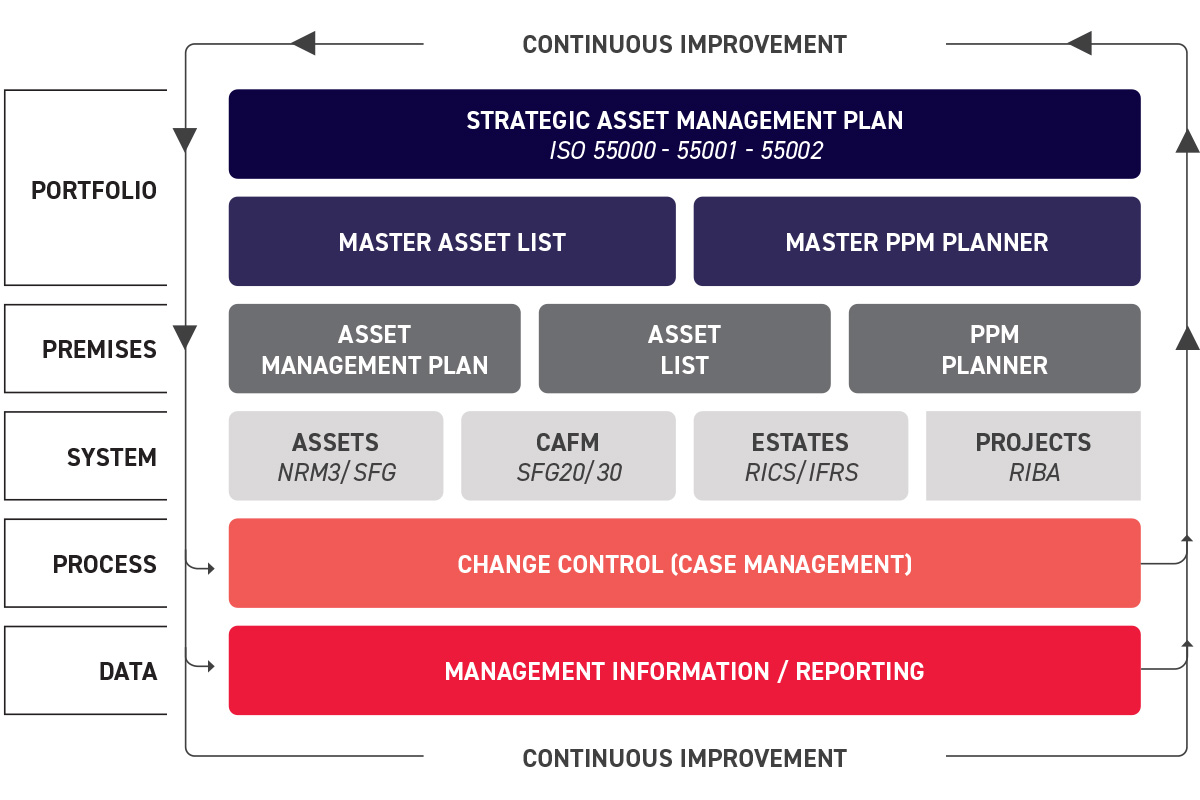
A Guide for Estate Managers
When it comes to managing buildings, infrastructure, and equipment, the costliest mistake an organisation can make is failing to plan. That’s where Strategic Asset Management Plans (SAMPs) come in.
A SAMP is more than a document, it’s a roadmap setting out how an organisation will manage its physical assets over the long term, aligning investment, maintenance, and operations with broader strategic goals. Whether you’re managing a university campus, a hospital estate, or a portfolio of government buildings, a SAMP helps you look beyond the next fix and plan for lasting performance.
Why Are Strategic Asset Management Plans Important?
Too often, decisions about maintenance and upgrades are made reactively, triggered by failure or squeezed into year-end budgets. This short-term mindset leads to higher costs, service disruptions, and missed opportunities for sustainability.
Government bodies like the National Audit Office (NAO) have highlighted this issue, and are pushing public sector organisations to take a more proactive, data-led approach. The message is clear: better data, better planning, better outcomes.
How Are Strategic Asset Management Plans Compiled and Who’s Involved?
Developing a SAMP is a collaborative process that draws on expertise across the organisation. It’s typically led by the estates or facilities team but should include input from:
- Finance teams, to align capital and operational budgets
- Senior leadership, to ensure strategic alignment
- Sustainability or energy managers, to embed environmental targets
- Health & safety and compliance officers, to manage statutory risks
- FM providers or external consultants, to provide asset data and technical insight
It begins with building a comprehensive understanding of the asset base; what assets exist, what condition they’re in, and what they’re worth. This usually involves condition surveys, digital asset registers, and performance benchmarking.
The plan then sets out long-term objectives, identifies risk-based priorities, and maps out investment strategies across 5, 10 or even 25-year horizons.
How Should Strategic Asset Management Plans Be Managed?
A SAMP isn’t a one-off exercise—it’s a living document that should evolve as assets change, budgets shift, or strategic goals are updated. Best practice includes:
- Annual reviews to ensure the plan stays relevant
- Integration with CAFM or asset management systems for real-time data visibility
- Board-level oversight to embed asset management into decision-making
- Clear governance so responsibilities and actions are owned and accountable
By embedding asset management into capital strategy, organisations can reduce lifecycle costs, improve resilience, and plan with confidence.
The Bottom Line
Strategic Asset Management Plans bring structure, foresight, and accountability to estate management. They shift the focus from short-term firefighting to long-term value creation. And with government initiatives highlighting the need for data-led planning, SAMPs are quickly becoming essential for any organisation managing complex assets.
Want to know more about what goes into a SAMP and how it can transform your estate strategy? Read our FAQs below!
Strategic Management Asset Plans: FAQs
1. What is a Strategic Asset Management Plan (SAMP)?
A Strategic Asset Management Plan (SAMP) is a high-level document that outlines how an organisation will manage its physical assets—such as buildings, infrastructure, and equipment—over the long term. It aligns asset management with the organisation’s goals, ensuring that investments are planned, sustainable, and effective.
2. Why do we need a SAMP?
SAMPs help organisations make smarter, long-term decisions about maintaining, upgrading, or disposing of assets. They reduce the reliance on reactive repairs, improve budget forecasting, enhance risk management, and support sustainability targets.
3. What are the key components of a SAMP?
A robust SAMP typically includes:
- An overview of the organisation’s asset portfolio
- Asset performance goals
- Lifecycle planning and cost forecasting
- Risk assessments and prioritisation strategies
- Maintenance and capital investment planning
- Links to sustainability, compliance, and organisational objectives
4. How does a SAMP differ from a maintenance plan?
A maintenance plan is usually short to medium-term and focuses on operational tasks like repairs and servicing. A SAMP takes a strategic, long-range view—looking at the full lifecycle of assets, investment planning, and how maintenance fits within broader goals.
5. Who should be involved in creating a SAMP?
Developing a SAMP typically involves estate and facilities teams, finance departments, senior leadership, sustainability officers, and sometimes external advisors or FM partners. Collaboration ensures alignment with both operational needs and strategic priorities.
6. How often should a SAMP be reviewed or updated?
A SAMP should be reviewed at least annually or whenever there’s a major change in assets, organisational priorities, funding, or policy. Regular updates help keep the plan responsive to emerging risks and opportunities.
7. What role does data play in a SAMP?
Accurate, up-to-date asset data is essential for a SAMP. Tools like condition surveys, digital asset registers, and CAFM systems support informed decision-making, risk assessments, and budget planning.
8. Is a SAMP a requirement for public sector organisations?
While not always mandatory, SAMPs are increasingly expected in the public sector—especially with government initiatives like the InSite programme, which promotes data-led estate planning and long-term asset strategies. Demonstrating a strategic approach can also support funding bids and compliance.
9. How does a SAMP support sustainability goals?
By planning for lifecycle performance and embedding sustainability criteria into investment decisions, a SAMP helps reduce environmental impact. It supports energy efficiency upgrades, carbon reduction, and responsible resource use.
10. What are the benefits of implementing a SAMP?
- Fewer reactive maintenance costs
- Better budgeting and cost control
- Improved asset reliability and performance
- Greater alignment with organisational strategy
- Enhanced compliance and risk management
- Stronger case for funding and investment
Strategic Management Asset Framework
This framework illustrates how a Strategic Asset Management Plan (SAMP) is supported by a structured, data-driven system that ensures assets are managed in line with ISO 55000 standards.

Get in touch to find out how DMA can help your organisation!



